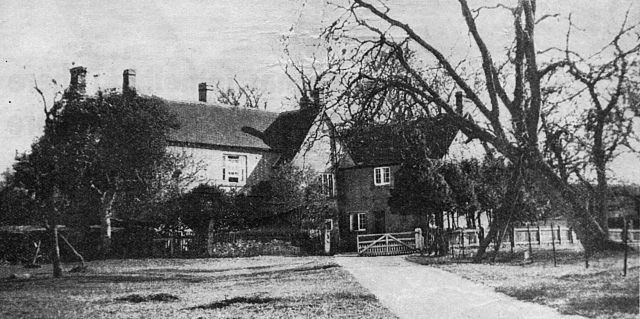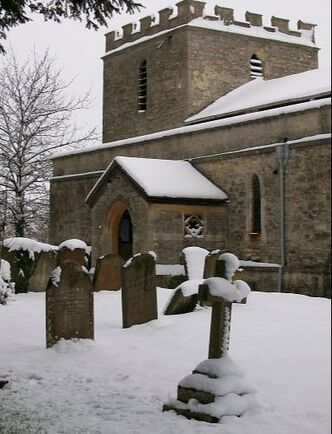History
Piddington People
Elizabeth Bottrell (1840–1901)
by David Cook
|
Elizabeth Mary Bottrell was born in Piddington in 1840, the youngest of William and Mary Anne Bottrell’s six children. William Bottrell was a tenant farmer in Piddington, as was his brother and his father before him. His wife, Mary Anne Alley, was from an established farming family in Islip. Elizabeth’s two brothers, Richard and William, died before she was born, at 6 and 3 months respectively. Her eldest sister Ann, died at the age of 12, when Elizabeth was less than a year old.
Elizabeth spent her childhood at the family farm in the middle of the village, now known as Laurell Farm. She lived there with her older sisters, Martha and Sarah. Sadly, their mother died at the age of 55, when Elizabeth was only 11. Their father died just 3 years later. Martha was 25 at the time, with Sarah nearly 18, and Elizabeth 14. They were without any immediate family support in the village, their aunt and uncle having died earlier. It seems that the three girls may have tried to run the farm for a while, perhaps with the help of their farming uncles and cousins from Islip. |
Three years after William Bottrell’s death, Elizabeth’s sister, Sarah, married and moved the short distance within the village to live with George Parrott, who by this time had taken over the running of the family’s wheelwright business. In the same year there was a farm sale of sheep, milk cows, pigs, horses, hay, barley and farm implements, “the property of the late Mr Bottrell.”
Eight months later, in May 1859, at the age of 19, Elizabeth married Charles Brown, a widower aged 30. George Alley, her 16-year-old cousin from Islip, was one of the witnesses to the marriage. Charles was born at the Manor Farm, the youngest son of John Brown and one of 3 brothers who farmed in Piddington and close by. Five years earlier Charles had married Elizabeth Griffin, the daughter of James Griffin who farmed at Muswell Hill. Sadly, she died in childbirth in the first year of their marriage, together with twin boys.
Eight months later, in May 1859, at the age of 19, Elizabeth married Charles Brown, a widower aged 30. George Alley, her 16-year-old cousin from Islip, was one of the witnesses to the marriage. Charles was born at the Manor Farm, the youngest son of John Brown and one of 3 brothers who farmed in Piddington and close by. Five years earlier Charles had married Elizabeth Griffin, the daughter of James Griffin who farmed at Muswell Hill. Sadly, she died in childbirth in the first year of their marriage, together with twin boys.
Just 3 weeks after her marriage, as Mrs Charles Brown, Elizabeth was one of the ladies to host the Tea Party to celebrate the opening of Piddington School. This event took place in a marquee in her husband’s field opposite the school. It was reported “to have been attended by about 500 people”. The following day “100 children were provided with a gratuitous tea.”
Elizabeth moved from Piddington to live with her husband at his large farm in Wretchwick on the London Road, close to Bicester. Her elder sister, Martha, also left the village to live with them.
Elizabeth’s life must have changed considerably through marriage. Before her marriage she was one of three young orphans. After, she became part of the large extended Brown family, comprising Charles’s mother, brothers, and sisters and before too long, twenty or more nieces and nephews in Piddington and villages nearby. Charles and Elizabeth had no children of their own but would often have their nieces and nephews to stay. They lived and farmed at Wretchwick for 15 years or more but spent considerable time in Piddington where Charles also had land. They became major benefactors in the village.
Charles, Elizabeth, and her sister Martha were strong supporters of St Nicholas Church and made donations to help build and run Piddington School. They each contributed towards the purchase of the church harmonium in 1861. Martha died in 1865 at the age of 35. At around this time Elizabeth’s other sister, Sarah Parrott, moved from Piddington to Tring where George established a successful coachbuilding business.
Elizabeth moved from Piddington to live with her husband at his large farm in Wretchwick on the London Road, close to Bicester. Her elder sister, Martha, also left the village to live with them.
Elizabeth’s life must have changed considerably through marriage. Before her marriage she was one of three young orphans. After, she became part of the large extended Brown family, comprising Charles’s mother, brothers, and sisters and before too long, twenty or more nieces and nephews in Piddington and villages nearby. Charles and Elizabeth had no children of their own but would often have their nieces and nephews to stay. They lived and farmed at Wretchwick for 15 years or more but spent considerable time in Piddington where Charles also had land. They became major benefactors in the village.
Charles, Elizabeth, and her sister Martha were strong supporters of St Nicholas Church and made donations to help build and run Piddington School. They each contributed towards the purchase of the church harmonium in 1861. Martha died in 1865 at the age of 35. At around this time Elizabeth’s other sister, Sarah Parrott, moved from Piddington to Tring where George established a successful coachbuilding business.
|
On her death she left the sum of £300, “the interest to be used for the lighting, warming, and other expenses of the Church”.
She left most of her estate, including Laurell Farm, to Thomas Tredwell Brown, “her ever favourite nephew”, a farmer at Woodeaton, married with 5 children. Just two years after Elizabeth’s marriage, the 1861 census records 4-year-old Thomas Tredwell Brown living with Elizabeth and Charles at their farm in Wretchwick. |
Charles and Elizabeth returned to live in Piddington when Charles retired. They bought Laurell Farm, Elizabeth’s childhood home. Charles died in 1884 at the age of 55. Elizabeth continued to live there for another 17 years until her death in 1901 at the age of 61.
On his death Charles Brown left £500 in trust to the Churchwardens, “the interest to be used for coals to be given to the Poor at Christmas”. The Piddington Coal Charity supplied coal to many villagers well into the 20th Century. To commemorate the Jubilee of Queen Victoria in 1887, Elizabeth paid for new bells for the church and to re-cast and re-hang the old bells. The following year she paid for the stone porch to be built outside the south door of the church. |




